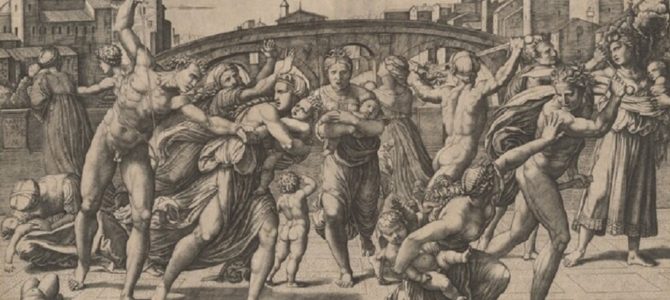
This year marks the 500th anniversary of the death of Raphael, one of the most important creative geniuses in the history of art, who for centuries both the art establishment and the public considered among the paragons of Western artistic achievement. Today, however, he is somewhat ignored and out of fashion, and artists who chose to operate more independently or outside of society’s mainstream are more highly regarded.
In the midst of this atmosphere, a new exhibition here in Washington DC seems to be weighing in on the question, “Does Raphael still matter?” The answer, however you choose to examine the question, is a resounding ‘Yes.”
“Raphael and His Circle,” which opened recently at the National Gallery of Art, brings together works from the museum’s collections of prints and drawings by the master and his associates, many of which are not regularly on view. If you can’t get to Rome or London later this year for the big shows marking “Raphael 500,” then this is probably your best opportunity stateside to take a good look at his output.
Not only is the NGA exhibition an intimately scaled look at Raphael and his followers’ works on paper, but after touring the exhibition you can head upstairs to see more of his work, since the museum also holds the largest number of paintings by Raphael in the Western Hemisphere.
Ambition Drove Raphael’s Pursuit of Excellence
Raffaello Sanzio (“Raphael”) (1483-1520), along with Leonardo da Vinci (1452-1519) and Michelangelo Buonarroti (1475-1564), was one of the most important figures of the Italian High Renaissance. After training under his father in his hometown of Urbino, Raphael eventually found his way to Florence, and later to Rome, where he became the favorite artist of two successive popes.
Today, he’s perhaps best known for his tender images of the Madonna and Child, such as the “Sistine Madonna” (1512) now in Dresden, his graceful portraits, like that of his good friend Baldassare Castiglione (c. 1515) in the Louvre, and the series of monumental frescoes he completed in the Papal apartments in the Vatican, including the iconic “School of Athens” (1509-1511).
The ambition to be successful drove Raphael to constantly seek to improve both himself and his art. “Raphael is a self-directed genius,” commented Jonathan Bober, curator and head of the Department of Old Master Prints at the National Gallery of Art, in introducing the exhibition. “He’s conscious, rational, and very different from Leonardo and Michelangelo, who are working in isolation. Raphael, on the other hand, is both thoughtful and aware of his surroundings.”
On top of his immense artistic talent, Raphael was also smart, handsome, stylish, popular, witty, and highly successful both financially and with the ladies. His brain worked like a sponge, soaking up not only lessons in art, but also in architecture, history, poetry, and a host of other interests. No wonder the often curmudgeonly and irascible Michelangelo couldn’t stand him. Even artist and art historian Giorgio Vasari (1511-1574), a commentator who was very much in Michelangelo’s pocket, famously referred to Raphael as “The Prince of Painters.”
How Raphael Used Drawings
Of course it’s drawings and prints, rather than paintings, that are the focus of the NGA’s new show. Drawing was actively encouraged in Raphael’s studio, not only as part of working out the designs for a specific project, but also for practice.
In his figure drawing, for example, sometimes the figures are of studio assistants, while sometimes they are people Raphael spotted on the street and whose appearance struck him. The drawings were held onto for future reference, so the master and his assistants could draw upon an ever-expanding library of ideas and inspiration for future projects.
Perhaps the single most astonishing work in the NGA show is the full-scale transfer drawing (known as a “cartoon”) for one of Raphael’s most famous paintings, “La Belle Jardinière” (1507), which is now in the Louvre. It’s hard to believe that this piece, made up of four sheets of paper joined together, has managed to survive for the past 500 years, particularly since it was poked full of holes to allow its contours to be transferred onto the panel where the artist later painted the finished work.

Close scientific examination of the drawing has revealed that, even at this late stage in the proceedings when he is almost ready to paint, Raphael was still working out certain design issues in his composition, such as the placement of the arm of the infant St. John the Baptist.
Prints Expanded Raphael’s Influence and Income
As to the prints in the show, although Raphael wasn’t a printmaker, like a growing number of artists in the early 16th century, he realized that prints of his work, based not only on his finished paintings but also based on original compositions he designed, would allow his work to become more widely known. Raphael’s fresco of Parnassus, for example, was affixed to the wall inside the Vatican and had to stay there, but an engraved print of that painting, like the one in the NGA show, could be reproduced multiple times, allowing copies to be sent to collectors not just in Italy, but all over Europe.
Eventually, Raphael began drawing original designs with the specific intent of having them turned into prints. An example in the show is the “Massacre of the Innocents” (c. 1511), a print by Raphael’s friend and collaborator Marcantonio Raimondi (1480-1534), based on drawings that Raphael created specifically for the project. Collaborations such as these proved highly lucrative for both artists: the prints were not only sought-after works of art in themselves, but served as easily distributed advertisements for Raphael and his associates.
After Raphael’s untimely death at the age of 37, his studio assistants and collaborators continued to work in and adapt his designs for many years, and later generations seeking a kind of Classical perfection in art came to idealize Raphael’s work ever more highly. By the end of the 19th century, Raphael had become something of a victim of his own success with both the art establishment and with the public, with poorly executed, over-sentimentalized reproductions or variants of his work decorating everything from biscuit tins to family Bibles. Today, however, his more convoluted and tortured contemporaries are more often held in much higher esteem.
The Golden Boy of the Renaissance
Part of this is due to the fact that Raphael was something of a golden boy. If the present-day narrative of art history needs to be altered by introducing or highlighting figures who do not fit neatly and gracefully into society in general, then Raphael is a prime candidate for exclusion. In this variant of the cancel culture phenomenon, Raphael can be ignored because both he and his art are too attractive, too conventional, or too elitist to be of value in a still-emerging bottom-up reinterpretation of Western art and culture.
Returning to the NGA exhibition, it’s certainly possible that one could dislike Raphael’s work, for various reasons. It’s also possible that one could reject his work method as being too rigid in its embrace of practice drawing, thereby resulting in an apparent lack of spontaneity. Questions of taste, style, philosophy, and so on, are infinitely debatable when weighing the merits of any artist. Yet Raphael’s centuries of influence had lasting ramifications for the history of art, which in the end renders him impossible to ignore.
Beyond his style and output, it’s the academic tradition inspired by Raphael and his studio that remains of critical importance today, even when most Modern and Contemporary Art looks nothing like the work he and his followers created. If you want to understand why an artist rejected the academic tradition, you need to understand what the academic tradition was, and indeed for at least some artists still is. More often than not, that tradition finds it roots in the work and work methods created by Raphael and his circle.
Here’s a Prime Example
Take a look at this highly idealized drawing of a warrior in profile, for example, or this life drawing of an old fisherman spotted sitting on the ground.


It will probably surprise you to learn that both drawings are by a very young Pablo Picasso (1881-1973), who at the time he executed these drawings was clearly studying his craft within an academic tradition inspired by Raphael’s example. The warrior head is so clean-lined as to almost be in a Raphael Revival style, while the use of street-figure-as-model is something Raphael often employed, as described earlier.
After finishing his training, Picasso chose to reject many of the Raphael-esque conventions of the academic education he received. Yet even after he did so, Picasso never stopped drawing, working out his ideas in preparatory sketches before he executed them in their final form, or creating original prints in collaboration with others in his circle, much as Raphael did. He may have turned his back on Raphael’s style, but as Picasso himself admitted, “Leonardo da Vinci promises us heaven, but Raphael gives it to us.”
While Raphael may no longer be a chic favorite artist, understanding his tremendous influence over the past five centuries is crucial to understanding the history and direction of art that came after him. “Raphael and His Circle” is at the National Gallery of Art in Washington DC through June 14.








